Ram Mandir, Ayodhya
Ram Mandir (Sanskrit: राम मंदिर) is an under-construction Hindu temple in Ayodhya, Uttar Pradesh, India, at the site of Ram Janmabhoomi, which many Hindus believe to be the birthplace of the Hindu god Rama.[5] The temple construction will be undertaken by Shri Ram Janmabhoomi Teerth Kshetra. The ground-breaking ceremony was performed on 5 August 2020 by Indian prime minister Narendra Modi.
| Ram Mandir, Ayodhya | |
|---|---|
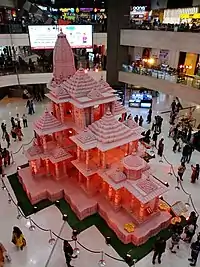 | |
| Religion | |
| Affiliation | Hinduism |
| Deity | Ram Lalla (infant form of Rama) |
| Festivals | Rama Navami, Diwali, Dussehra |
| Location | |
| Location | Ram Janmabhoomi, Ayodhya, Uttar Pradesh, India |
 Shown within Uttar Pradesh  Ram Mandir, Ayodhya (India) | |
| Geographic coordinates | 26.7956°N 82.1943°E |
| Architecture | |
| Architect(s) | Sompura family (Chandrakant Sompura[3] Nikhil Sompura and Ashish Sompura[4]) |
| Creator | Shri Ram Janmabhoomi Teerth Kshetra Construction by Larsen & Toubro (assisted by CBRI, National Geophysical Research Institute and IITs) |
| Groundbreaking | 5 August 2020 |
| Completed | Under construction |
| Temple(s) | 1 |
| Ayodhya dispute |
|---|
| Organizations |
History
Background
Rama, considered an incarnation of god Vishnu, is a widely worshiped Hindu deity. According to the ancient Indian epic, Ramayana, Rama was born in Ayodhya. In the 16th century, the Mughals constructed a mosque, the Babri Masjid which is believed to be the site of the Ram Janmabhoomi, the birthplace of Rama. A violent dispute arose in the 1850s.
In the 1980s, the Vishwa Hindu Parishad (VHP), belonging to the Hindu nationalist family Sangh Parivar, launched a new movement to reclaim the site for Hindus and to erect a temple dedicated to the infant Rama (Ram Lalla) at this spot. In November 1989, the VHP laid the foundations of a temple on land adjacent to the disputed mosque. On 6 December 1992, the VHP and the Bharatiya Janata Party organised a rally at the site involving 150,000 volunteers, known as kar sevaks. The rally turned violent, and the crowd overwhelmed the security forces and tore down the mosque.[6][7]
The demolition resulted in several months of intercommunal rioting between India's Hindu and Muslim communities, causing the death of at least 2,000 people, and triggering riots all over the Indian subcontinent.[8] A day after the demolition of the mosque, on 7 December 1992, The New York Times reported that "30 Hindu temples across Pakistan" were attacked, some set on fire, and one demolished. The government of Pakistan closed school and offices in a day of protest.[9] Hindu temples in Bangladesh were also attacked.[6] Some of these Hindu temples that were partially destroyed during the retaliation of Babri Masjid have since remained that way.[10] Further violence against Hindu structures in Pakistan was prevented by the Pakistan Army and local Muslim community.[11]
A 1978 and 2003 archaeological excavation by the Archaeological Survey of India (ASI) found evidence indicating that Hindu temple remains had existed on the site.[12][13] Archeologist KK Muhammad accused several historians of undermining the findings.[14] Over the years, various title and legal disputes also took place, such as the passage of the Acquisition of Certain Area at Ayodhya Ordinance, 1993. It was only after the 2019 Supreme Court verdict on Ayodhya dispute that it was decided the disputed land be handed over to a trust formed by the Indian government for the construction of a Ram temple. The trust was eventually formed under the name Shri Ram Janmabhoomi Teerth Kshetra. Five acres of land was allocated for the mosque 22 km away in the city in Dhannipur village.[15] On 5 February 2020, it was announced in the Parliament that the Narendra Modi government had accepted a plan to construct the temple.
Prior construction efforts
In the 1980s, the VHP collected funds and bricks with "Shree Ram" written on them. Later, the Rajiv Gandhi government gave the VHP permission for Shilanyas (the foundation stone ceremony), with the then Home Minister Buta Singh formally conveying the permission to the VHP leader Ashok Singhal. Initially the centre and state governments had agreed upon the conducting of the Shilanyas outside of the disputed site. However, on 9 November 1989, a group of VHP leaders and Sadhus laid the foundation stone by digging a 200-litre (7-cubic-foot) pit adjacent to the disputed land. The singhdwar (transl. main entrance) of the sanctum was laid here.[16] Kameshwar Chaupal (a Dalit leader from Bihar) became one of the first people to lay the stone.[17]
Deity
Ram Lalla Virajman, the infant form of Rama, an avatar of Vishnu, is the presiding deity of the temple.[18] Ram Lalla's dress is stitched by tailors Bhagwat Prasad and Shankar Lal; Shankar Lal is a fourth generation tailor to Rama's idol.[19][20]
Ram Lalla was a litigant in the court case over the disputed site since 1989, being considered a "juristic person" by the law.[4] He was represented by Triloki Nath Pandey, a senior VHP leader who was considered as Ram Lalla's next 'human' friend.[18]
Architecture
The original design for the Ram temple was prepared in 1988 by the Sompura family of Ahmedabad.[4] The Sompuras have been part of the temple design of over 100 temples all over the world for at least 15 generations.[21] The chief architect of the temple is Chandrakant Sompura. He was assisted by his two sons Nikhil Sompura and Ashish Sompura, who are also architects.[17]
A new design, with some changes from the original, was prepared by the Sompuras in 2020,[17] in accordance with vastu shastra and the shilpa shastras.[22] The temple will be 235 feet wide, 360 feet long and 161 feet high. Once complete, the temple complex will be the world's third largest Hindu shrine.[17] It is designed in the Nagara style of Indian temple architecture.[21] A model of the proposed temple was showcased during the Prayag Kumbh Mela in 2019.[23]
The main structure of the temple will be built on a raised platform and will have three storeys. It will have five mandapas in the middle of the garbhagriha (sanctum sanctorum) and the entry — the three mandapas Kudu, Nritya, and Rang; and two mandapas for the Kirtan and Prarthana on the other side. In Nagara style, the mandapas are to be decorated with shikhara. The tallest Shikhara will be that above the Garbhagriha.[24] The building will have a total of 366 columns. The columns will have 16 idols each to include the incarnations of Shiva, the Dashavataras, the chausath joginis, and the 12 incarnations of the goddess Saraswati. The width of the stairs will be 16 feet. In accordance with scriptures dedicated to the design of temples dedicated to Vishnu, the sanctum sanctorum will be octagonal.[22] The temple will be built in 10 acres and 57 acres of land will be developed into a complex with a prayer hall, "a Ramkatha Kunj (lecture hall), a Vaidik Pathshala (educational facility), a Sant Niwas (saints' residence) and a Yatri Niwas (hostel for visitors)" and other facilities like a museum and a cafeteria.[16][24]
Construction
The Shri Ram Janmabhoomi Teerth Kshetra trust began the first phase of construction of the Ram Temple in March 2020.[25][26] However, the COVID-19 pandemic lockdown in India followed by the 2020 China–India skirmishes caused a temporary suspension of the construction.[27][28] During ground-leveling and excavation of the construction site a Shivaling, pillars and broken idols were found.[29] On 25 March 2020, Ram's idol was moved to a temporary location in the presence of Chief Minister Yogi Adityanath.[30] In preparation for its construction, the Vishwa Hindu Parishad organised a 'Vijay Mahamantra Jaap Anushthan', in which individuals would gather at different places to chant the Vijay Mahamantra – Shri Ram, Jai Ram, Jai Jai Ram, on 6 April 2020. This was said to ensure "victory over hurdles" in the construction of the temple.[31]
Larsen & Toubro offered to oversee the design and construction of the temple free of cost and is the contractor of the project.[32][33] Central Building Research Institute, National Geophysical Research Institute and the Indian Institute of Technology (such as those Bombay, Guwahati and Madras) are assisting in areas such as soil testing, concrete and design.[34][35][36] Reports emerged that the Indian Space Research Organisation (ISRO) had identified a stream of the Sarayu which flows under the temple.[37][36]
The construction work will be accomplished with 600 thousand cubic feet of sandstone Bansi mountain stones from Rajasthan.[22][24] Thirty years ago, more than two hundred thousand bricks etched with the 'Sri Rama' in several languages had arrived from various parts of the country; these will be utilized in the foundation.[24] Traditional techniques will be used to create the shrine while at the same time it will be made sure that the shrine will be strong enough to sustain natural calamities such as earthquakes. There will be no use of iron in the construction of the temple. The fusing of the stone blocks will require ten thousand copper plates.[38]
Bhoomi Poojan ceremony
The temple construction officially started again after a Bhoomi Poojan ceremony on 5 August 2020. Three-day long Vedic rituals were held ahead of the ground-breaking ceremony, which revolved around the installation of a 40 kg silver brick as the foundation stone by the Prime Minister of India, Narendra Modi.[4] On 4 August, the Ramarchan Puja was performed, an invitation to all the major gods and goddesses.[39]
On the occasion of the Bhoomi-Pooja, soil and holy-water from several religious places across India, Triveni Sangam of rivers Ganga, Yamuna, Saraswati at Prayagraj, Kaveri river at Talakaveri, Kamakhya Temple in Assam and many others, were collected.[40][41][42] Soil was also sent from various Hindu temples, Gurudwaras and Jain Temples across the nation to bless the upcoming temple. Among the many was Sharada Peeth located in Pakistan.[43][44][45] Soil was also sent form the four pilgrimage locations of Char Dham.[46] Temples in United States, Canada and Caribbean Islands held a virtual service to celebrate the occasion.[47] Rama's image were shown at Times Square.[48][49] All 7,000 temples in a 7 km radius of Hanumangarhi were also asked to join in the celebrations by lighting diyas.[50] Muslims devotees in Ayodhya who consider Rama as their ancestor also looked forward to the bhoomi-puja. Spiritual leaders from all faiths were invited on the occasion.[51]
On 5 August, Prime Minister Modi first offered prayers at Hanumangarhi to seek blessings of Hanuman for the day's events.[52][53] Following this the ground breaking and foundation stone laying ceremony of Ram Mandir took place.[52] Yogi Adityanath, Mohan Bhagwat, Nritya Gopal Das and Narendra Modi gave speeches.[52] Modi started his speech with Jai Siya Ram and he went on to urge those in attendance to chant Jai Siya Ram.[54][55][56] He stated, "the call of Jai Siya Ram is resonating not only in the city of Lord Ram but throughout the world today" and that "Ram Mandir will become the modern symbol of our traditions".[57][58] Narendra Modi also paid his respects to the many who had made sacrifices for the Ram temple.[59] Mohan Bhagwat also thanked L. K. Advani for his contributions to the movement to get the temple built.[59] Modi also planted a sapling of the Parijat.[60] In front of the deity, Modi performed a dandvat pranam/ sashtang pranam, lying completely prone on the ground with hands outstretched in prayer.[61] Due to the COVID-19 pandemic, attendees at the temple were limited to 175.[52]
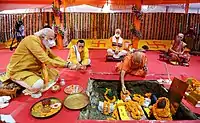 Narendra Modi performing Bhoomi Pujan at the groundbreaking. Also visible are Mohan Bhagwat and Anandiben Patel.
Narendra Modi performing Bhoomi Pujan at the groundbreaking. Also visible are Mohan Bhagwat and Anandiben Patel.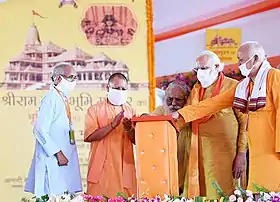 PM Narendra Modi and CM Yogi Adityanath and other dignitaries unveiling the plaque to lay the foundation stone of Ram Janmabhoomi Mandir
PM Narendra Modi and CM Yogi Adityanath and other dignitaries unveiling the plaque to lay the foundation stone of Ram Janmabhoomi Mandir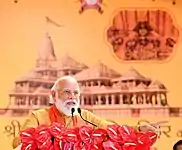 PM Modi at the foundation stone laying ceremony of Ram Temple with proposed architecture design in background.
PM Modi at the foundation stone laying ceremony of Ram Temple with proposed architecture design in background.
- Reactions to the ground-breaking ceremony
Orthodox priests and religious leaders complained that the ceremony did not follow proper ritual procedures, pointing out, among others, that 5 August was not a ritually auspicious date and that the function did not include a havan.[62] In this respect, writer Arundhati Roy pointed out that the chosen date marked one year since the revocation of the special status of Jammu and Kashmir, arguing that the decision to schedule the ceremony for 5 August, an inauspicious date with no significance in the Hindu calendar, symbolized the conclusion of a period "in which India under Modi has formally declared itself a Hindu Nation, the dawning of a new era."[63][8] Among the international community, Pakistan made an official statement through its Pakistan Foreign Office related to the temple.[64] The Times of India also reported that post Ram Mandir ground–breaking, Pakistani Hindus fear violence in the same way as what happened in 1992.[65]
Various Indian political leaders hailed the ground-breaking ceremony. While some openly celebrated it, others worded their statements carefully.[66] Many expressed hope in furthering the country's progress by following the ideals of Ram.[67] Soon after the ground-breaking ceremony, residents of Ayodhya expressed hope in improvements of job opportunities and development of the city, through tourism generated by the temple.[68]
Nationwide crowdfunding and outreach
The temple trust decided to launch a nationwide "mass contact and contribution campaign" aimed at reaching 55-60 crore people.[36] Voluntary donations of ₹10 (14¢ US) and higher will be accepted. It will be an opportunity for followers of Ram to continue to be a part of the Janmabhoomi movement.[69]
On 15 January 2021, President of India Ram Nath Kovind made the first contribution towards the construction of the Ram Mandir by donating ₹501,000 (US$7,000).[70] This was followed by several leaders and eminent personalities across the nation. The Shri Ram Janmabhoomi Teerth Kshetra Trust said that about ₹2,300,000,000 (US$32 million) was endowed as of 30 January 2021.[71]
In popular culture
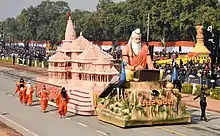
During the 2021 Delhi Republic Day parade on Rajpath, Uttar Pradesh's tableau showcased a replica of the Ram Mandir.[72]
Mandir wahi banayenge is an expression in Indic languages, translating as "the temple will be built there". It is one of the most popular slogans in relation to Ram Janmabhoomi movement and Ram Mandir used as early as 1985-86, popularized in the 1990s, and has a number of variations.[73][74] The slogan has been used in both positive and negative connotations. It has been a symbol of hope and it has become a part of festivities on one hand, while on the other it has become a part of standup comedy, jokes and memes.[75] In 2019, the slogan was used in the Parliament of India,[75] and has also been used by media houses.[76][77] The slogan has been used as a threat as well as a vow.[78]
There are variations of the slogan such as one used by Lal Krishna Advani: "Saugandh Ram ki Khat-e hain; Hum Mandir Wahin Banayegein" (transl. We take a vow in the name of Rama: we will build the temple exactly there).[73] Other variations and adaptations include "Wahin Banega Mandir" (transl. A temple will be built there),[76] "Jaha Ram Ka Janma Hua Tha, Hum Mandir Wahi Banayenge" (transl. The temple will be built where Ram was born),[74] "Ram Lalla Hum Aayenge; Mandir Wahi Banayenge" (transl. We are coming Ram Lalla, the temple will be built there)[74] and "Pehle mandir, fir sarkaar" (transl. First the temple, then the government).[79]
See also
References
- "Delhi's Pacific Mall installs 32-foot-tall replica of Ayodhya's Ram temple ahead of Diwali". India Today. 25 October 2020. Retrieved 9 January 2021.
- "With replica of Ayodhya's Ram Temple, West Delhi's Pacific Mall mall showcases faith". The New Indian Express. 24 October 2020. Retrieved 9 January 2021.
- Umarji, Vinay (15 November 2019). "Chandrakant Sompura, the man who designed a Ram temple for Ayodhya". Business Standard. Retrieved 27 May 2020.
- Pandey, Alok (23 July 2020). "Ayodhya's Ram Temple Will Be 161-Foot Tall, An Increase Of 20 Feet". NDTV. Retrieved 23 July 2020.
- Bajpai, Namita (7 May 2020). "Land levelling for Ayodhya Ram temple soon, says mandir trust after video conference". The New Indian Express. Retrieved 8 May 2020.
- Anderson, John Ward; Moore, Molly (8 December 1992). "200 Indians killed in riots following mosque destruction". Washington Post. Retrieved 29 August 2020.
- Fuller, Christopher John (2004), The Camphor Flame: Popular Hinduism and Society in India, Princeton University Press, p. 262, ISBN 0-691-12048-X
- Kidangoor, Abhishyant (4 August 2020). "India's Narendra Modi Broke Ground on a Controversial Temple of Ram. Here's Why It Matters". TIME. Retrieved 17 November 2020.
For Muslims in India, it is the site of a 16th century mosque that was demolished by a mob in 1992, sparking sectarian riots that led to some 2,000 deaths.
- "As a reaction to Babri Masjid demolition, What had happened in Pakistan and Bangladesh on 6 December, 1992". Reuters. The New York Times. 8 December 1992 [1992]. Retrieved 30 May 2020 – via The Morning Chronicle.CS1 maint: others (link)
- Khalid, Haroon (14 November 2019). "How the Babri Masjid Demolition Upended Tenuous Inter-Religious Ties in Pakistan". The Wire. Retrieved 30 May 2020.
- Latif, Aamir (3 December 2019). "Memories of Babri Mosque demolition haunt Pakistani Hindus". Anadolu Agency. Retrieved 17 November 2020.
- Bhattacharya, Santwana (6 March 2003). "I found pillar bases back in mid-seventies: Prof Lal". The Indian Express Archive. Retrieved 7 October 2020.
- "Proof of temple found at Ayodhya: ASI report". Rediff. PTI. 25 August 2020. Retrieved 7 October 2020.CS1 maint: others (link)
- Shekhar, Kumar Shakti (1 October 2019). "Ram Mandir existed before Babri mosque in Ayodhya: Archaeologist KK Muhammed". The Times of India. Retrieved 21 September 2020.
- "Dhannipur near Ayodhya already has 15 mosques, local Muslims want hospital and college too".
- "Grand Ram temple in Ayodhya before 2022". The New Indian Express. IANS. 11 November 2019. Retrieved 26 May 2020.CS1 maint: others (link)
- Bajpai, Namita (21 July 2020). "280-feet wide, 300-feet long and 161-feet tall: Ayodhya Ram temple complex to be world's third-largest Hindu shrine". The New Indian Express. Retrieved 23 July 2020.
- "Ayodhya Case Verdict: Who is Ram Lalla Virajman, the 'Divine Infant' Given the Possession of Disputed Ayodhya Land". News18. 9 November 2019. Retrieved 4 August 2020.
- "अयोध्या: 5 अगस्त को इस टेलर का सिला पोशाक पहनेंगे रामलला" [On 5 August Ram will wear clothes stitched by this tailor]. News18 India (in Hindi). 27 July 2020. Retrieved 27 July 2020.
- "What the idol of Ram Lalla will don for the Ayodhya temple 'bhoomi pujan' - Divine Couture". The Economic Times. 4 August 2020. Retrieved 4 August 2020.
- Sampal, Rahul (28 July 2020). "Somnath, Akshardham & now Ram Mandir – Gujarat family designing temples for 15 generations". ThePrint. Retrieved 29 July 2020.
- Misra, Leena (6 August 2020). "Meet the Sompuras, master architects who are building the Ram Temple in Ayodhya". The Indian Express. Retrieved 14 August 2020.
- "Ayodhya Ram Mandir construction to begin in April this year: Trustee". Business Standard India. Press Trust of India. 6 February 2020. Retrieved 9 May 2020.
- Husain, Yusra (31 July 2020). "Ram Mandir design: Nagara style of architecture for Ayodhya's Ram temple". The Times of India. Lucknow. Retrieved 11 August 2020.
- Sharma, Pratul (23 March 2020). "1st phase of Ram temple construction begins in Ayodhya". The Week. Retrieved 9 May 2020.
- "Ram Mandir Construction: राम मंदिर निर्मितीच्या पहिल्या टप्प्यातील काम सुरू" [Ram Mandir Construction: Ram mandir Foundation Starts First Phase of Work]. Times Now Marathi (in Marathi). 8 May 2020. Retrieved 8 May 2020.
- Bajpai, Namita (9 April 2020). "Ram Mandir plans continue during COVID-19 lockdown, temple trust releases its official Logo". The New Indian Express. Retrieved 9 May 2020.
- "COVID-19: लॉकडाउन खत्म होते ही अयोध्या में शुरू होगा भव्य राम मंदिर निर्माण" [COVID-19: The Ram Temple construction will begin in Ayodhya after the end of lockdown]. News18 India (in Hindi). 1 January 1970. Retrieved 8 May 2020.
- "Shivling, carvings on sandstone found at Ram Janmabhoomi site: Temple trust". The Times of India. ANI. 21 May 2020. Retrieved 27 May 2020.
- Rashid, Omar (25 March 2020). "U.P. Chief Minister Adityanath shifts Ram idol amid lockdown". The Hindu. ISSN 0971-751X. Retrieved 24 July 2020.
- "VHP to organise 'Vijay Mahamantra Jaap Anushthan'". Outlook. IANS. 4 April 2020. Retrieved 2 August 2020.
- "L&T to oversee the construction of Ram temple: Vishwa Hindu Parishad". Business Standard. 3 March 2020. Retrieved 6 August 2020.
- Bajpai, Namita (29 February 2020). "L&T ready to construct Ram temple in Ayodhya for free, say VHP leaders". The New Indian Express. Retrieved 6 August 2020.
- Mishra, Avaneesh (10 September 2020). "Ayodhya Ram Temple construction: L & T reaches out to IIT-M for expert help on design, concrete". The Indian Express. Retrieved 17 November 2020.
- Shah, Pankaj (21 August 2020). "Ram temple: CBRI and IIT-Madras tests Janmabhoomi soil". The Times of India. Retrieved 17 November 2020.
- Rashid, Omar (4 January 2021). "Work on Ayodhya Ram temple foundation to begin by January-end, says trust". The Hindu. ISSN 0971-751X. Retrieved 9 January 2021.
- "Ram temple trust asks IITs to suggest models for strong foundation of temple". Hindustan Times. PTI. 30 December 2020. Retrieved 9 January 2021.CS1 maint: others (link)
- "Construction of Ram Mandir in Ayodhya begins". ANI News. 20 August 2020. Retrieved 17 November 2020.
- "'Ramarchan puja' begins ahead of 'bhoomi pujan' in Ayodhya". DNA India. 4 August 2020. Retrieved 5 August 2020.
- Mehta, Kriti (22 July 2020). "Ram temple bhumi pujan: Sangam soil, water to be taken to Ayodhya; proceedings to be telecast live". The Times Of India.
- "Water, soil from Kodagu sent to Ayodhya". Deccan Herald. 24 July 2020.
- "Sacred Soil of Kamakhya Temple taken for Construction of Ram Mandir". Guwahati Plus. 28 July 2020. Retrieved 28 July 2020.
- Singh, Akhilesh (26 July 2020). "VHP sends soil from gurdwara, Valmiki temple to Ayodhya". The Times of India. Retrieved 26 July 2020.
- "Soil from Sharda Peeth in Kashmir to be used in Ram Mandir foundation in Ayodhya". The Kashmir Monitor. 25 July 2020. Retrieved 26 July 2020.
- "Soil from 11 places in Delhi sent for Ayodhya Ram Temple Bhoomika pujan". United News of India. 24 July 2020. Retrieved 26 July 2020.
- Roy, Suparna (26 July 2020). "Char Dham soil and Ganga water to be sent to Ayodhya for Ram Temple Bhumi Pujan". Hindustan Times. Retrieved 30 July 2020.
- "Temples in North America to hold virtual prayer to celebrate Ayodhya Ram Temple's foundation laying ceremony". The Hindu. PTI. 1 August 2020. ISSN 0971-751X. Retrieved 1 August 2020.CS1 maint: others (link)
- "Lord Ram's images to be displayed in Times Square to celebrate August 5 Ayodhya Temple groundbreaking ceremony". The Hindu. PTI. 30 July 2020. ISSN 0971-751X. Retrieved 1 August 2020.
- "Largest digital display of Lord Ram shines in New York's Times Square". The New Indian Express. Retrieved 8 August 2020.
- Sharda, Shailvee (1 August 2020). "UP: On the threshold of change, Ayodhya braces for transition". The Times of India. Retrieved 1 August 2020.
- "Muslim devotees of Lord Ram gear up to celebrate temple 'bhoomi pujan' in Ayodhya". The Hindu. PTI. 27 July 2020. ISSN 0971-751X. Retrieved 2 August 2020.CS1 maint: others (link)
- Ray, Meenakshi, ed. (5 August 2020). "After bhoomi poojan at Ayodhya, RSS' Mohan Bhagwat says we have fulfilled our resolve". Hindustan Times. Retrieved 5 August 2020.
- "PM Modi gifted silver crown, headgear at Ayodhya's Hanuman Garhi temple". The Indian Express. 5 August 2020. Retrieved 8 August 2020.
- "From Laos to Lanka, Ram is everywhere: PM Modi in Ayodhya". India Today. 5 August 2020. Retrieved 5 August 2020.
- "'Jai Siyaram' call resonating throughout the world: PM Narendra Modi". The Times of India. 5 August 2020. Retrieved 5 August 2020.
- "Long wait ends today: PM chants 'Jai Siya Ram' in Ayodhya". Punjab News Express. 5 August 2020. Retrieved 5 August 2020.
- "With Jai Siya Ram, PM Modi departs from Jai Shri Ram chant at bhoomi pujan". India Today. 5 August 2020. Retrieved 5 August 2020.
- "Ram Mandir Will Be A Modern Symbol Of Our Traditions: PM Modi". BW Businessworld. 5 August 2020. Retrieved 5 August 2020.
- Tripathi, Ashutosh, ed. (5 August 2020). "At Ayodhya Ram temple event, PM Modi reiterates mantra to fight coronavirus". Hindustan Times. Retrieved 5 August 2020.
- Jain, Sanya (5 August 2020). "Watch: PM Narendra Modi Plants Parijat Sapling At Ram Temple". NDTV.com. Retrieved 5 August 2020.
- "Ram Mandir Bhoomi Pujan : राम लला को साष्टांग प्रणाम किया प्रधानमंत्री मोदी ने, जानें क्या है इसका महत्व". Times Now Hindu (in Hindi). 5 August 2020. Retrieved 5 August 2020.
- Pradhan, Sharat (7 August 2020). "At Ayodhya Bhoomi Pujan, Modi Became All-in-One; Proper Rituals Not Followed, Allege Pundits". thewire.in. Retrieved 7 August 2020.
- Roy, Arundhati (5 August 2020). "India's Day of Shame". thewire.in. Retrieved 5 August 2020.
- "Pakistan criticises India for starting construction of Ram temple in Ayodhya". The Hindu. PTI. 28 May 2020. ISSN 0971-751X. Retrieved 17 November 2020.CS1 maint: others (link)
- Rana, Yudhvir (2 August 2020). "Pakistani Hindu fears more attacks after Ram Mandir foundation in Ayodhya". The Times of India. Retrieved 17 November 2020.
- Menon, Aditya (5 August 2020). "Ram Mandir: Which Secular Leaders Hailed Bhoomi Pujan & Who Didn't". TheQuint. Retrieved 14 August 2020.
- "Ayodhya Ram Mandir Ceremony: Leaders Hope Development Would Pave Way For Harmony". Outlook. PTI. 5 August 2020. Retrieved 14 August 2020.
- Pandey, Neelam (5 August 2020). "Ram Mandir is more than an emotive issue for Ayodhya's youth — it means new opportunities". ThePrint. Retrieved 13 August 2020.
- Pandey, Neelam (15 December 2020). "Ram Mandir trust to launch nationwide fund collection drive next month for temple construction". ThePrint. Retrieved 9 January 2021.
- https://indianexpress.com/article/india/president-kovind-donates-rs-5-lakh-for-ram-temple-construction-7147458/
- "Over ₹230 cr collected as donations for Ram temple construction: Trust". Hindustan Times. 29 January 2021. Retrieved 2 February 2021.
- "Ayodhya on Rajpath: UP's Republic Day tableau showcases replica of Ram temple". Zee News. Retrieved 2 February 2021.
- Verma, Nalin (4 August 2020). "'Mandir Wahin Banayenge' Said L.K. Advani 30 Years Ago, But Will Stay Home on August 5". The Wire. Retrieved 2 February 2021.
- Hemanth, S. A. (10 November 2019). "'Slogans we shouted in '85 have come true today'". Deccan Chronicle. Retrieved 2 February 2021.
- Kundu, Swapnajit (5 August 2020). "How 'Mandir Wahin Banega' gained prominence". Deccan Herald. Retrieved 2 February 2021.
- "'Sir Ram': A look at how some Hindi and English newspapers covered the #AyodhyaVerdict". Newslaundry. 10 November 2019. Retrieved 2 February 2021.
- Krishnan, Revathi (4 August 2020). "ABP News all excited about Ram temple, India Today & NDTV 24x7 focus on J&K woes". ThePrint. Retrieved 2 February 2021.
- Sharma, Sandipan (4 August 2020). "Mandir Wahin Banayenge: After 30 years, BJP's tryst with Hindutva destiny". The Federal. Retrieved 2 February 2021.
- "Uddhav Wonders For How Long Will People be 'Fooled' With 'Mandir Wahi Banayenge' Slogan". News18. PTI. 22 November 2018. Retrieved 2 February 2021.CS1 maint: others (link)
External links
 Media related to Ram Mandir, Ayodhya at Wikimedia Commons
Media related to Ram Mandir, Ayodhya at Wikimedia Commons